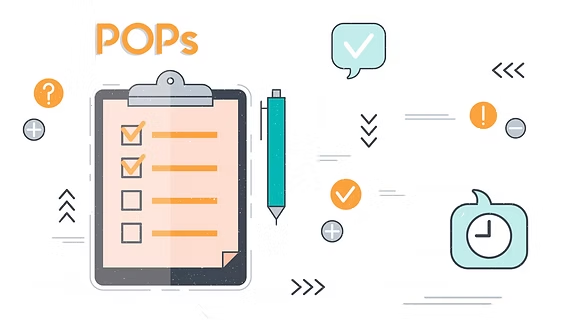In modern organizations, the pursuit of efficiency, consistency, and quality has become a constant priority. As businesses grow and processes become more complex, maintaining standardization is essential to guarantee that tasks are executed with the same precision every time. One of the most effective resources to achieve this is the Protocolo Operacional Padrao (POP), or Standard Operating Procedure (SOP).

This article explores what a Protocolo Operacional Padrao is, why it is so important for organizations, how to implement it successfully, and the benefits it brings across different industries.
What is a Protocolo Operacional Padrao?
A Protocolo Operacional Padrao is a document that describes, step by step, how to perform a particular activity or process within an organization. Its main function is to ensure that tasks are carried out consistently, regardless of who is responsible for them.
Instead of leaving procedures open to interpretation, the POP defines them clearly and objectively. This reduces errors, improves quality, and provides a reference point for employees at all levels.
Key characteristics of an effective Protocolo Operacional Padrao include:
- Clarity: To prevent misunderstandings, the writing is straightforward and uncomplicated.
- Detail: Contains all necessary instructions and resources for the task.
- Accessibility: Available to all team members who need it.
- Flexibility: Updated frequently to accommodate organizational or legal modifications.
Why is a Protocolo Operacional Padrao essential?
Implementing a Protocolo Operacional Padrao creates value in multiple ways:

- Standardization of processes – Tasks are performed in the same way every time, reducing variability.
- Quality assurance: Adherence to rules and industry norms is bolstered by consistency.
- Training and onboarding – New employees learn faster when they have clear instructions to follow.
- Risk reduction – Minimizes mistakes that can lead to accidents, delays, or financial loss.
- Operational efficiency – Optimizes time and resources by eliminating unnecessary steps.
- Knowledge preservation – Captures institutional knowledge so it remains even if staff turnover occurs.
For industries such as healthcare, food production, finance, or manufacturing, POPs are not only practical but often a legal requirement to guarantee safety and compliance.
How to develop a Protocolo Operacional Padrao
Creating a POP requires careful planning and collaboration among teams. Here is a structured approach:
1. Identify the process
Select which procedure needs standardization. Focus on critical or frequently repeated tasks that influence quality or compliance.
2. Define the objective
State why the Protocolo Operacional Padrao is necessary. For example: “Ensure safe medication administration” or “Standardize customer service responses.”
3. Gather input from staff
Involve employees who perform the task daily. Their expertise ensures the POP reflects reality and not just theoretical assumptions.
4. Document the steps
Write down each step of the process clearly and in sequence. To make things easier to follow, use numbering or bullet points.

5. Specify responsibilities
Assign roles—who does what, and at what stage of the process.
6. Include required resources
List the tools, equipment, and materials necessary to execute the procedure.
7. Define quality standards
Add measurable indicators, such as deadlines, safety checks, or acceptable limits for performance.
8. Review and approve
Managers or compliance officers should evaluate the POP before implementation.
9. Train staff
Hold training sessions to make sure everyone is aware of and regularly follows the Protocolo Operacional Padrao.
10. Monitor and update
Regularly review the document to incorporate improvements, new regulations, or updated technologies.
Practical examples of Protocolo Operacional Padrao
To better understand its applications, let’s see how POPs function in different sectors:
Healthcare
- Objective: Standardize patient discharge.
- Steps: Verify prescriptions, provide discharge instructions, update electronic records, and schedule follow-up.
- Result: Reduces errors and improves patient safety.
Food Industry
- Objective: Maintain hygiene during food preparation.
- Steps: Clean surfaces, keep raw and cooked food separate, and keep an eye on the temperature in the refrigerator.
- Result: Ensures compliance with health standards and prevents contamination.
Customer Service
- Objective: Handle complaints consistently.
- Steps: Record issue, acknowledge customer concern, escalate if necessary, and provide resolution within a defined timeframe.
- Result: Builds trust and improves customer satisfaction.
Manufacturing
- Objective: Standardize equipment maintenance.
- Steps: Turn off equipment, check parts, swap out worn parts, and test the system.
- Result: Minimizes downtime and increases productivity.
Best practices for effective POPs
- Use visuals: Diagrams and flowcharts help explain complex steps.
- Keep it concise: Long documents discourage use; focus only on essential details.
- Ensure accessibility: Make POPs available both digitally and in print.
- Assign accountability: A responsible person should oversee compliance.
- Encourage feedback: Employees can suggest improvements for better efficiency.
Conclusion
An crucial tool for firms seeking to improve process quality, efficiency, and consistency is a Protocolo Operacional Padrao. By documenting and standardizing tasks, companies reduce errors, facilitate training, preserve knowledge, and ensure compliance with regulations.
From healthcare to manufacturing, customer service to food safety, POPs transform everyday operations into structured systems that deliver reliable results. In an increasingly competitive world, adopting a well-designed Protocolo Operacional Padrao can be the difference between average performance and operational excellence.
By investing time and effort into creating and updating POPs, organizations build stronger foundations for sustainable growth and long-term success.





